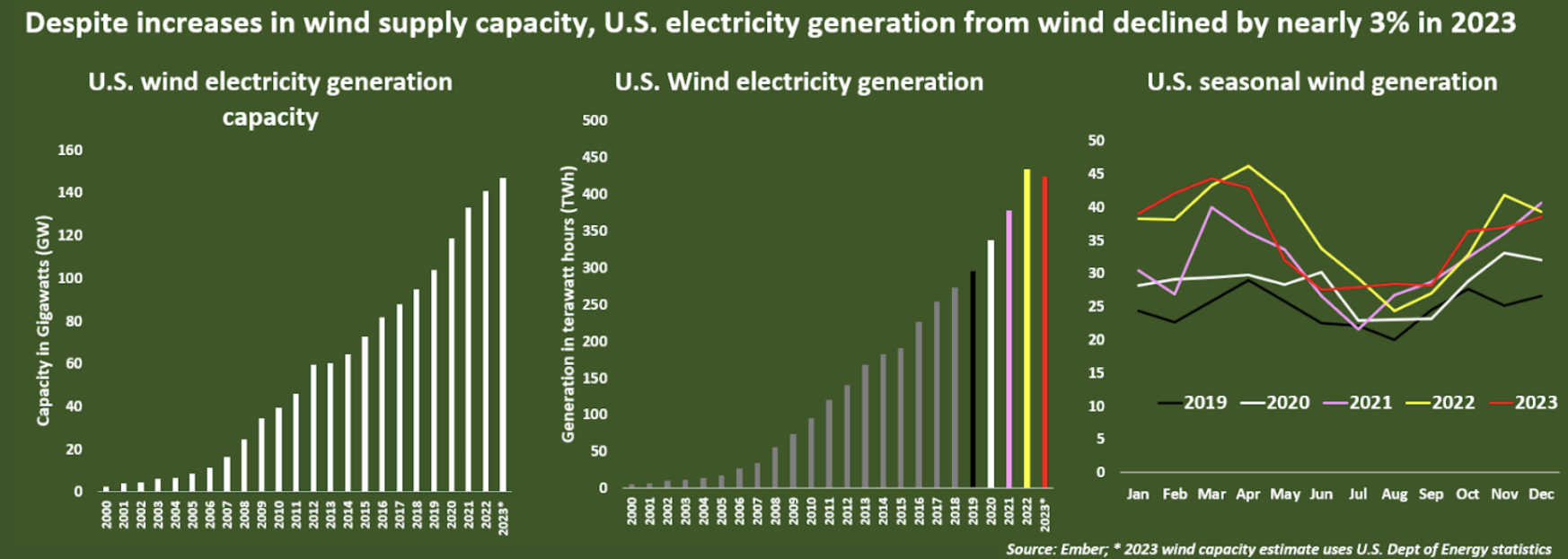Renewable electricity generation in the United States hit new highs in 2023 but expanded by its smallest margin since 2012, due to below-normal wind speeds and a drought-driven decline in hydroelectric power, as renewable energy is generally dependent on the whims of the weather. For Americans to rely on renewable energy for electricity generation makes them dependent on the weather for energy that is needed for keeping their lights on, for heating their homes and businesses, and for providing a healthy economy. The drop in wind generation came despite new additions to wind supply capacity throughout the country, and forced several major utilities, including in the top wind state Texas, to offset lower wind generation with higher natural gas generation to meet electricity demand.
Besides unusually low wind speeds – especially during April, May, June and November, supply chain disruptions alongside increased material and labor costs and borrowing costs caused a slowdown in wind project installations in 2023. Those factors resulted in a nearly 3 percent drop in total wind generation. Hydroelectricity was also down due to low river levels in western states. Only a big increase in solar installations, which the Department of Energy estimates grew from 17 gigawatts in 2022 to 31 gigawatts in 2023, and output had renewable generation eke out a small gain of less than 0.5 percent. The slow growth resulted despite additions to renewable energy supply capacity throughout the country. Capacity does not necessarily equate to actual generation with non-dispatchable, weather-dependent electricity sources. Last year also resulted in the first contraction in overall electricity generation since COVID-19 lockdowns stifled total energy use in 2020—a 2 percent contraction.
The average annual increase in U.S. wind capacity between 2015 and 2022 was 9.5 gigawatts, so a similar increase in wind capacity was expected in 2023. According to the Department of Energy, U.S. wind supply capacity was estimated to have increased by between 7.1 gigawatts and 12 gigawatts in 2023. The exact number is currently not known. By the end of 2022, the United States had 141 gigawatts of wind capacity and 113 gigawatts of solar capacity, second only to China in either technology.
Of the six largest wind power producing states – Texas, Iowa, Oklahoma, Kansas, Illinois and North Dakota – only Texas generated more electricity from wind in January through May 2023 compared to the same period in 2022. The remaining states recorded an average wind generation decline of 7.1 percent, which contributed to a 3.1 percent decline in total national wind generation in the January to May period. The Electric Reliability Council of Texas (ERCOT), the Midcontinent Independent System Operator (MISO), and the Southwest power pool recorded wind power drops of 2.3 percent, 8.9 percent and 1.3 percent respectively in the first eight months of 2023 from the same period in 2022.

Some believe that the key factor behind the below-average wind speeds in 2023 was the El Nino weather pattern that led to a warming in Pacific Ocean water temperatures, lower pressure in subtropical areas and a slowing in the trade winds across the United States. Average U.S. wind speeds in key wind power generation areas were between 1 and 3 meters per second below the long-term average in May of 2023. Wind power output usually peaks in the winter and spring and hits annual lows during summer.
Hydroelectric generation dropped by more than 7 percent in 2023 due to drought in key hydro generation areas, especially in western states. Combined, hydro and wind facilities generated around 665 terawatt hours of electricity in 2023, compared to 695 terawatt hours in 2022—a drop of over 4 percent. About a 19 percent increase in solar generation helped to offset some of the lower wind and hydro output. Non-carbon electricity generation (renewable and nuclear) increased in 2023 and resulted in a share of 41 percent. Nuclear continues its steady production of around 20 percent of total electricity generation, as it has since 1990.
Fossil fuels, mainly coal and natural gas, still accounted for around 59 percent of total U.S. electricity generation last year. Coal-fired electricity output declined by around 19 percent in 2023—the lowest total coal output since 2020 during the COVID lockdown. Gas-fired electricity generation increased by around 7 percent from 2022’s total, and total electricity output from fossil fuels contracted by 2 percent last year to its lowest level since 2020, following the contraction in electricity demand.
2023 Was a Bad Year for Offshore Wind
In 2023, despite having to pay penalties, several offshore wind developers cancelled their projects due to escalating costs and lack of agreement to renegotiate offshore wind generation prices by government officials. Offshore wind is the most expensive renewable technology and the most expensive technology currently being built in the United States. The cancellations are resulting in halving President Biden’s goal of 30 gigawatts of offshore wind by 2030 to just 15 gigawatts.
Conclusion
U.S. power producers increased output of electricity from natural gas more than from renewable energy power sources in 2023, as electricity firms grappled with low wind speeds. That increase in gas generation eclipsed the growth in electricity generated from non-carbon power sources, including nuclear, solar, wind and hydro power, indicating the need for fossil fired electricity to keep America’s lights on.
California, which has the country’s highest proportion of renewable energy, also had to increase output from natural gas. Power companies are likely to remain heavy users of natural gas through the cooling and heating seasons, underscoring natural gas’s critical role in the U.S. power system, even as renewables capacity continues to grow. Intermittent wind and solar power at maximum levels can only produce a quarter to a half of what fossil fuel and nuclear plants can attain because of their low capacity factors and weather dependency.